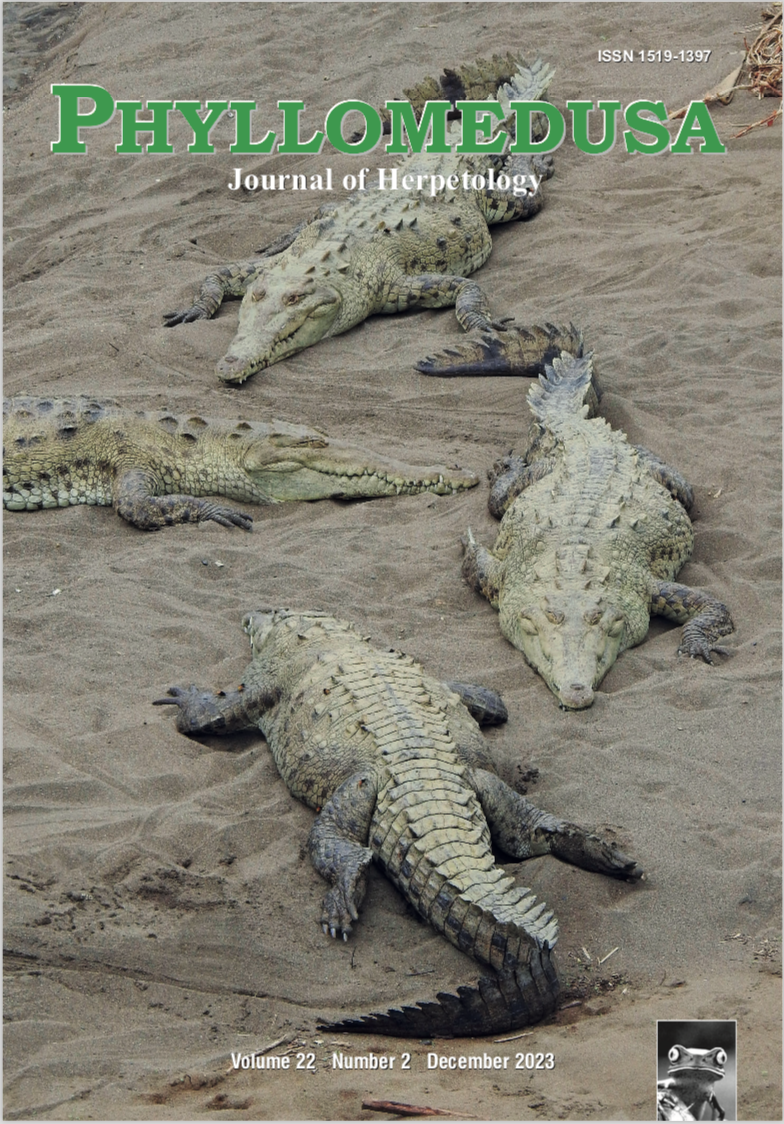A chance encounter in central Texas yields insights on the ecology of aestivating Siren nettingi (Caudata: Sirenidae)
DOI:
https://doi.org/10.11606/issn.2316-9079.v22i2p131-137Keywords:
Amphibian, Conservation, Dormancy, Dynamic habitat, Roadways, WetlandAbstract
Siren spp. are often dominant vertebrates in the wetlands they occupy and are known to estivate when such wetlands dry up. Practical considerationslimit in-situ observations of estivating individuals. On 12 October 2021, we incidentally discovered an estivating aggregate of Siren nettingi in Bastrop County, Texas, USA. These salamanders were excavated from compact, rocky soil adjacent to a caliche road, at depths that ranged between ~0.2 to 1.5 m. The dominant vegetation at this site included Ulmus crassifolia, Persicaria sp., and various grass species. We recovered 140 individuals of which seven were salvaged and 133 were captured live. We measured 115 of these for snout–vent length (SVL) and observed the aggregate was predominated by juveniles. We estimated an estivation density of 2.33 sirens/m2 that is comparable to densities estimated for non-estivating populations. However, in-lieu of monitoring that was in place for this study, we expect a mass mortality event would have likely occurred. We therefore suggest that roadway construction in preferred habitat be considered as a threat to siren populations.
Downloads
References
Aresco, M. J. and M. S. Gunzburger. 2004. Efects of largescale sediment removal on herpetofauna in Florida wetlands. Journal of Herpetology 38: 275–279.
Bassett, L. G. 2023. Updated geographic distributions for Texas amphibians. Reptiles & Amphibians 30: e18486.
Bohannon, A. M. A., L. G. Bassett, F. E. Zughaiyir, S. Sirsi, A. Villamizar-Gomez, S. Bullard, and M. R. J. Forstner. 2022.
Geographic distribution. Siren intermedia (Lesser Siren). Herpetological Review 53: 69.
Cagle, F. R. and P. E. Smith. 1939. A winter aggregation of Siren intermedia and Triturus viridescens. Copeia 1939: 232–233.
Davis, W. B. and F. T. Knapp. 1953. Notes on the salamander Siren intermedia. Copeia 1953: 119–121.
Dixon, J. R. 2013. Amphibians and Reptiles of Texas, With Keys, Taxonomic Synopses, Bibliography, and Distribution Maps. 3rd Edition. College Station. Texas A&M University Press. 447 pp.
Fedler, M. T., K. M. Enge, and P. E. Moler. 2023. Unraveling Siren (Caudata: Sirenidae) systematics and description of a small, seepage specialist. Zootaxa 5258: 351–378.
Frese, P. W., A. Mathis, and R. Wilkinson. 2003. Population characteristics, growth, and spatial activity of Siren intermedia in an intensively managed wetland. Southwestern Naturalist 48: 534–542.
Gehlbach, F. R. and S. E. Kennedy. 1978. Population ecology of a highly productive aquatic salamander (Siren intermedia). Southwestern Naturalist 23: 423–430.
Gehlbach, F. R., R. Gordon, and J. B. Jordan. 1973. Aestivation of the Salamander, Siren intermedia. American Midland Naturalist 89: 455–463.
Goin, C. J. 1942. Description of a new race of Siren intermedia Le Conte. Annals of the Carnegie Museum 29: 211–217.
Graham, S., R. Kline, D. A. Steen, and C. Kelehear. 2018. Description of an extant salamander from the Gulf Coastal Plain of North America: the Reticulated Siren, Siren reticulata. PLoS ONE 13: e0207460.
Luhring, T. M. and R. M. Holdo. 2015. Trade-ofs between growth and maturation: the cost of reproduction for surviving environmental extremes. Oecologia 178: 723–732.
Luhring, T. M., G. M. Connette, and C. M. Schalk. 2016. Trap characteristics and species morphology explain size-biased sampling of two salamander species. Amphibia-Reptilia 37: 79–89.
Martof, B. S. 1973. Siren intermedia. Catalogue of American Amphibians and Reptiles 127: 1–3.
Martof, B. S. 1974. Sirenidae. Catalogue of American Amphibians and Reptiles 151: 1–2.
Petranka, J. W. 2010. Salamanders of the United States and Canada. Washington. Smithsonian Institution. 587 pp.
Powell, R., R. Conant, and J. T. Collins. 2016. Peterson Field Guide to Reptiles and Amphibians of Eastern and Central North America. New York. Houghton Mifin Harcourt. 494 pp.
Powell, R., J. T. Collins, and E. D. Hooper. 2019. Key to the Herpetofauna of the Continental United States and Canada. 3rd Edition. Lawrence. Kansas University Press. 184 pp.
Secor, S. M. and J. H. Lignot. 2010. Morphological plasticity of Vertebrate aestivation. Pp. 183–208 in C. A. Navas and J. Carvalho (eds.), Aestivation. Progress in Molecular and Subcellular Biology. Vol. 49. Berlin, Heidelberg. Springer.
Trauth, S. E., R. L. Cox, B. P. Butterfeld, D. A. Saugey, and W. E. Meshaka. 1990. Reproductive phenophases and clutch characteristics of selected Arkansas amphibians. Proceedings of the Arkansas Academy of Science 44: 107–113.
Downloads
Published
Issue
Section
License
Copyright (c) 2023 ESALQ-USP

This work is licensed under a Creative Commons Attribution-NonCommercial-NoDerivatives 4.0 International License.
All material originally published in Phyllomedusa belongs to Escola Superior de Agricultura Luiz de Queiroz - Universidade de São Paulo. All contents are under a license of Creative Commons BY-NC-ND.


 Impact Factor (JCR): 0.600
Impact Factor (JCR): 0.600 CiteScore: 1.0
CiteScore: 1.0